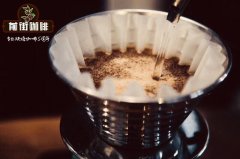What is the difference between Yunnan Baoshan Katim coffee beans and Yunnan Katim honey processing sweet?

Professional coffee knowledge exchange more coffee bean information please follow the coffee workshop (Wechat official account cafe_style)
Qianjie-Katim variety introduction
The cultivation of coffee in Baoshan began in the mid-1950s, and the first coffee seedling was introduced by the late patriotic overseas Chinese Mr. Liang Jinshan in Southeast Asia. Baoshan Coffee planting area is located at the eastern foot of Gaoligong Mountain, which belongs to the dry and hot valley. The climate belongs to the monsoon climate of the south subtropical eastern dry summer humid plateau, with sufficient sunshine, rich heat, less Rain Water, warm winter and less fog, and no frost all the year round. Enjoy the laudatory name of "natural greenhouse" and "tropical treasure land".
The local famous Lujiangba small-grain coffee, with excellent quality, won the gold medal at the 42nd Brussels Eureka Expo in 1993, and was called "world-class quality" and "planting level" by world-class coffee experts such as Brazil, Turkey, Indonesia and so on. In recent years, with the expansion of international trade, Lujiangba's small-grain coffee is more famous.
Merchants in Europe, the United States, Egypt, Hong Kong and Macao, especially in Britain, the United States, Egypt, Hong Kong and Macao all regard it as the best coffee, and the products are in short supply. In December 2010, after being examined and approved by the General Administration of quality Supervision, Inspection and Quarantine of China, it was decided to implement the protection of national geographical indication products for "Baoshan small Coffee". By the end of 2016, the planting area of coffee in Baoshan City was 260000 mu, with a total output of 35000 tons. Mainly distributed in Longyang, Longling, Changning and Shidian counties (cities).
Baoshan is one of the first areas to grow coffee in Yunnan. At present, the varieties of small-grain coffee planted in Baoshan are Catimor, Coffea Arabica var.typicaCramer and coffea Arabica var. Bourbon Choussy), Kaddura variety (coffea Arabica var. Caturra KMC), Mondonovo (mundoNovo culti var), S288.
At present, in the dry and hot valleys of the Nujiang and Lancang River basins in Baoshan, small grains of coffee are planted in more than 20 hot towns in the city. By 2016, the planting area of Baoshan coffee was 260000 mu, with a total output of 35000 tons, with an output value of 1.01 billion yuan, ranking third in the province and second in total output. Baoshan small grain coffee has been exported to Britain, France, Spain, Canada, the United States, Russia and other countries, and entered the Thai market for the first time, earning more than 30 million US dollars from exports, which is generally praised by foreign customers.
Laos belongs to the northern tropical and subtropical humid monsoon climate, with an annual average temperature of 20.1 ℃, matching low temperature with drought, sufficient light and a large temperature difference between day and night. The annual precipitation is 1700mm to 2060mm. With an average elevation of 800-1700 meters, it is the most suitable area for coffee cultivation.
The Lao government has a strong awareness of environmental protection, strictly controls the use of pesticides and chemical fertilizers, and the coffee produced meets the requirements of organic products. The Borofen Plateau is the only coffee producing area in Asia with pozzolanic soil.
Katim honey treatment cup test flavor: tropical fruit, chocolate, flower flavor, nut flavor Laos geographical conditions are more suitable for the cultivation of coffee trees, honey treatment methods for the treatment of higher technical requirements, so that coffee fruit flavor is more intense.
Knowledge: as early as 1892, a missionary from France brought coffee to Yunnan and successfully planted the first coffee tree in a place called Zhu Kula.
In short: Qianjie is a coffee research hall, happy to share the knowledge about coffee with you, we share unreservedly just to make more friends fall in love with coffee, and there will be three low-discount coffee activities every month. The reason is that Qianjie wants to make more friends drink the best coffee at the lowest price, which has been Qianjie's tenet for 6 years!
END
Important Notice :
前街咖啡 FrontStreet Coffee has moved to new addredd:
FrontStreet Coffee Address: 315,Donghua East Road,GuangZhou
Tel:020 38364473
- Prev

The difference between Yunnan Coffee Bean Iron pickup and Katim Why is the flavor of Katim coffee beans criticized
Professional coffee knowledge exchange more coffee bean information please follow the coffee workshop (Wechat official account cafe_style) Qianjie-Katim varieties introduction Katim: Yunnan coffee varieties are mainly mixed-race varieties infected with Robusta gene Katim, which is very different from Taiwan's traditional Tibika, but the interesting thing is, evil
- Next

Do Yunnan coffee beans have Yunnan customs? what are the common varieties of Yunnan coffee beans?
Professional coffee knowledge exchange more coffee bean information please follow the coffee workshop (Wechat official account cafe_style) Qianjie-Katim varieties introduction of Yunnan coffee varieties Yunnan coffee varieties mainly Typica and Bourbon this two classic high-quality coffee varieties as the main cultivation varieties, in 1991 the Katim Catimor series was introduced from Kenya
Related
- Beginners will see the "Coffee pull flower" guide!
- What is the difference between ice blog purified milk and ordinary milk coffee?
- Why is the Philippines the largest producer of crops in Liberia?
- For coffee extraction, should the fine powder be retained?
- How does extracted espresso fill pressed powder? How much strength does it take to press the powder?
- How to make jasmine cold extract coffee? Is the jasmine + latte good?
- Will this little toy really make the coffee taste better? How does Lily Drip affect coffee extraction?
- Will the action of slapping the filter cup also affect coffee extraction?
- What's the difference between powder-to-water ratio and powder-to-liquid ratio?
- What is the Ethiopian local species? What does it have to do with Heirloom native species?

